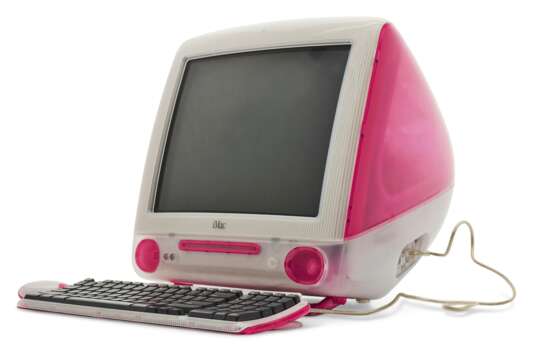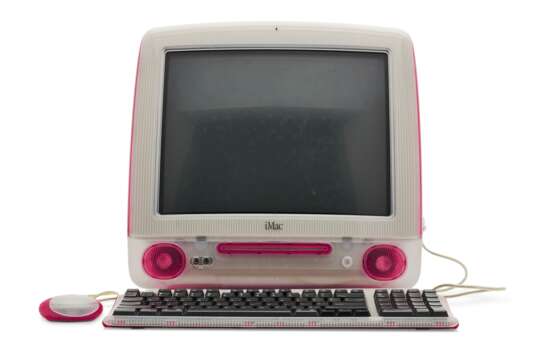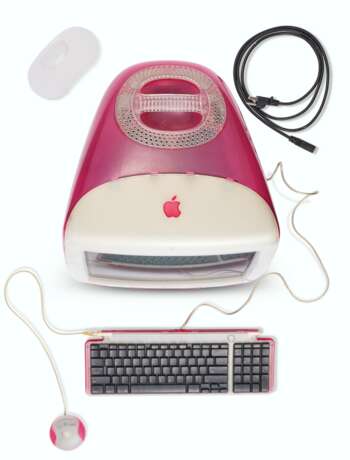ID 688116
Los 2000 | A Strawberry iMac
Schätzwert
$ 100 000 – 150 000
Early in 2000, Wales and his partners had spearheaded an ambitious project: they would develop a free, online, user-sourced encyclopedia called Nupedia. But as the year came to a close, the project was languishing with barely a handful of articles complete. Wales was contemplating abandoning the entire endeavor, but on Boxing Day, a highly personal event changed everything:
"…my first child Kira was born, but with a serious medical condition—she was immediately whisked away to intensive care and I eventually ended up at home frantically researching (as any new parent would) the condition, trying to learn more. I sat down to this very computer and started my research.
And of course, back then, the result was a mess. There was no straightforward, concise, and trustworthy source of information to explain something like this to me. I decided to double-down on my efforts rather than give up—I could see and feel in an emotional way the importance of quality information. After she got out of the hospital, I installed a primitive ‘wiki software’ package and on January 15, 2001, Wikipedia was launched.
This computer was a part of the early days of Wikipedia in many other ways. I remember getting up at night, fearful that someone would come and vandalize the whole site—it was so open, so vulnerable, and in the early days the software was such that I was the only person who could block vandals.
On September 11, 2001 I had been up online nearly all night, and early that morning got a call from a loved one saying that I should turn on the television. I was exhausted but ended up spending most of the day on this computer watching Wikipedia evolve in real time to—for the first time—give a comprehensive coverage of background information relating to the World Trade Center attacks."
The Strawberry iMac additionally recalls the reemergence of Apple as major player in the computer world after experiencing the corporate equivalent of a near-death experience in the mid-1990s. By the time Jimmy Wales was starting Wikipedia, Apple was preparing to release its Mac OS X operating system. Today Apple and Wikipedia, while vastly different in nearly every respect, both dominate their respective fields and are household names across the globe.
This Strawberry iMac, as with most electronics, soon became obsolete (though in the interim it did take on a second life as his daughter's computer for playing "Blues Clues" and the like). It went into storage and today is offered together with its original box (as was expected back in the year 2000). Wales also used a computer at the offices of Bomis, the company who initially oversaw and funded the Wikipedia project. That unit has long since been lost.
Nupedia becomes Wikipedia
Originally envisioned as a peer-reviewed and edited encyclopedia in the mold of the venerable Britannica, but sourcing raw contributions not only from experts but also from the general public, Jimmy Wales and then editor-in-chief Larry Sanger realized that they needed a more efficient means of attracting more contributions. They decided to employ Ward Cunningham’s wiki software, a system that enabled users to collaboratively edit web pages, as a feeder project to inject new life in the Nupedia project—appropriately named Wikipedia.
Wikipedia launched on 15 January 2001 and the project quickly took on a life of its own–rapidly outpacing the development of Nupedia. Within a month the site hosted 1,000 articles. In May 2001, eleven non-English editions of Wikipedia had been established including versions in German, French, Italian, Chinese, Hebrew, Japanese, Portuguese, Spanish, Catalan, and even Esperanto. By September 2001 the number of articles had reached 10,000, and a year later that number had doubled to 20,000. The prospect of selling advertising as a revenue stream to support Wikipedia, while contemplated at the project’s inception, was soon quashed by Wales. Advertising did not conform with Wales’s aesthetic vision for the project, and it would have flown the face of the all-volunteer ethos that had defined the project from the start. In 2003, Wales established the Wikimedia Foundation which was charged with supporting a sprawling network of volunteer writers and editors across the globe writing tens of thousands of articles in multiple languages.
From its inception, Wikipedia was, and still is, mostly the product of volunteers, or Wikipedians, who write and edit articles guided by a set of core principles that are now enshrined in the five pillars of Wikipedia. The most notable, and controversial, is the site’s commitment to writing with a neutral point of view. The other pillars include the basic guidance that Wikipedia is an encyclopedia and no more, and stressing all content be verifiable from other sources and not contain original research or mere opinion; that the content is free for anyone to "use, edit, and distribute"; that contributors and editors should treat each other with "respect and civility"; and, finally, that "Wikipedia has no firm rules." The ethos was very much the embodiment of the open-source movement of the time, and signaled a new era in the history of the internet: the rise of a collaborative movement that would transform the landscape of the digital world.
At the time of writing, the size of Wikipedia has mushroomed: over 57 million articles in over 300 languages, overseen by nearly many thousands of volunteer editors who collectively have been responsible for over 3 billion edits. If the whole of Wikipedia were to appear in print, it is estimated it would require about 21,500 volumes. Wikipedia is, in its own words as "the largest and most-read reference work in history."
370 x 370 x 370mm
| Adresse der Versteigerung |
CHRISTIE'S 20 Rockefeller Plaza 10020 New York Vereinigten Staaten | ||||||||||||||
|---|---|---|---|---|---|---|---|---|---|---|---|---|---|---|---|
| Vorschau |
| ||||||||||||||
| Telefon | +1 212 636 2000 | ||||||||||||||
| Fax | +1 212 636 4930 | ||||||||||||||
| Nutzungsbedingungen | Nutzungsbedingungen | ||||||||||||||
| Versand |
Postdienst Kurierdienst Selbstabholung | ||||||||||||||
| Zahlungsarten |
Banküberweisung | ||||||||||||||
| Geschäftszeiten | Geschäftszeiten
|







